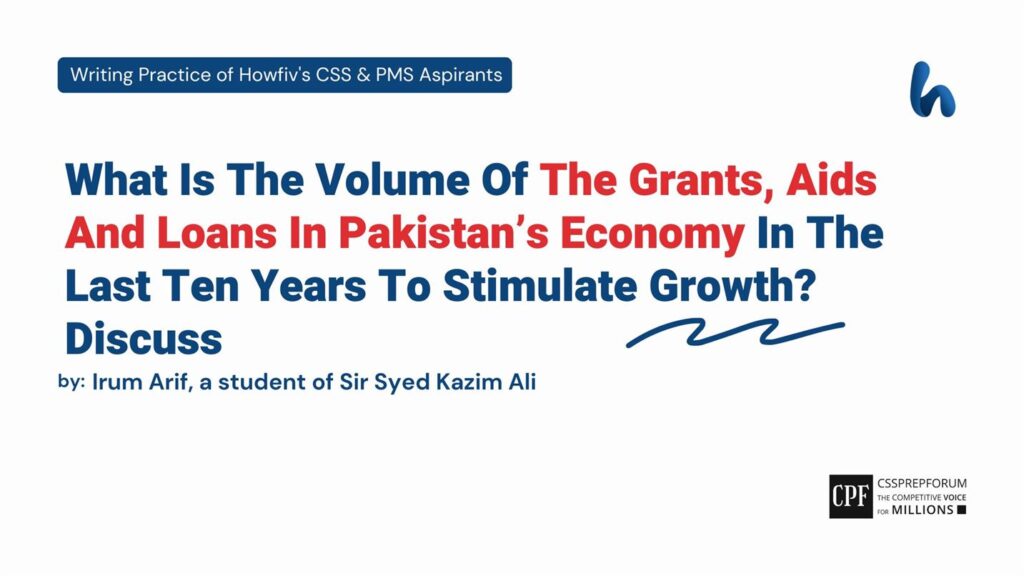CSS Solved Pakistan Affairs Past Paper 2022 | What Is The Volume Of The Grants, Aids And Loans In Pakistan’s Economy In The Last Ten Years To Stimulate Growth? Discuss
The following question of CSS Pakistan Affairs 2022 is solved by Irum Arif under the supervision of Miss Nirmal Hasni. She learnt how to attempt 20 marks question and essay writing from Sir Syed Kazim Ali, Pakistan’s best CSS and PMS English essay and precis teacher with the highest success rate of his students. This solved past paper question is attempted on the pattern taught by Sir to his students, scoring the highest marks in compulsory and optional subjects for years, and uploaded to help aspirants understand how to crack a topic or question, how to write relevantly, what coherence is, and how to include and connect ideas, opinions, and suggestions to score the maximum.
Question Breakdown
In this question, the examiner asked you to highlight the volume of the grants, aids and loans Pakistan took from external sources, specifically in the last ten years, to encourage growth. So, first, start your answer with the explanation of the terms “grants, aids and loans”. Second, write about the need for taking loans, aid and grants from Pakistan. Then tell about the volume taken by Pakistan in the last ten years. Then, moving ahead towards the discussion, you can discuss the positive and negative impacts of such actions on Pakistan. After this, you can also give some suggestions to decrease the reliance on foreign loans and aid. However, it is not essential to give suggestions, so you can do this part if you have time. Lastly, end your answer with powerful critical analysis and a conclusion paragraph.

Outline
Introduction
2. What are foreign grants, loans and aids?
3. Why does Pakistan need grants, aids and loans?
- Balance of payment crisis
- Stimulate economic growth
- Manage natural disasters
- Promote investment
4. Overview of the last ten years’ grants, aids and loans
- From International Financial Institutes
- From Regional Financial Institutes
- From countries
5. Impacts of grants, aids and funds on Pakistan
Positive impacts
- Source of revenue and public investment programmes
- Stabilized balance of payment crisis
- Helped to deal with natural calamities
Negative impacts
- No actual growth but the increased burden of loans
- Increased dependence on institutes and countries
- Impact on independent decision making
6. Ways to decrease dependence on foreign grants and loans
7. Critical analysis
8. Conclusion

Answer to the Question
INTRODUCTION
A strong economy is indispensable for a country’s social, political and economic development. Developing countries, having a weak economies, rely on foreign sources of revenue to fulfil the needs of their society and people. Similarly, Pakistan is also one of those countries that went to international financial institutions and other donor entities to take loans, aid and grants. According to the record of IMF, Pakistan went 22 times to the institution to receive bailouts and loans since its inception. Moreover, the Kingdom of Saudi Arabia, the United Arab Emirates, and China are among the biggest donors to Pakistan. The country relies on aid and grants to overcome the balance of payment crisis, stabilize its economy, and deal with natural disasters. The foreign aid, loans and grants have created positive as well as negative impacts on the economy of Pakistan. Thus, there is a need for the country to rely on its indigenous resources, expand its tax base, and invest in its people to overcome the economic crisis rather than relying on external elements.
What are foreign grants, loans and aids?
It is important to understand the terms foreign aid, grant and loans before continuing with the details of the volume of the grants, aid and loans in Pakistan’s economy in the last ten years to stimulate growth. These terms are often used interchangeably; however, there is a difference between all these terms. Foreign aid means transferring funds or resources from one state to another to benefit the one receiving it. The purpose of the aid can be to help a country overcome its food crisis, to reward it for some action, or just to develop good bilateral ties. Aid is based on the urgency of the matter, in contrast to the grants given for some particular projects. Some departments or foundations give foreign grants to non-private entities for education or health purposes. Similarly, the foreign loan is the inflow of money, especially borrowed from Bretton wood institutions (IMF and WB) on negotiable terms followed by a strict repayment schedule. Pakistan, being a developing country, has relied on all three for various reasons, as explained below.
Why does Pakistan need grants, aids and loans?
Pakistan has relied on foreign grants and loans since its inception as a developing country. Various factors are responsible for the country’s dependence on loans and aid. Pakistan has been a victim of unstable economic growth; from being an Asian tiger in the 1960s to an economically dependent state in the 1990s, it has taken multiple aid and loan packages to mitigate the prevalent economic crisis. In 1958, Pakistan went to the IMF for the first time due to a fiscal crisis and received a loan of 25 million SDR. Then, it became a habit for the Pakistani government to go to monetary organizations for loans and help in emergency preparedness during natural disasters. Sometimes the grants received by Pakistan were to improve the investment atmosphere in the country. The China-Pakistan Economic Corridor is a case in point. Moreover, Pakistan relied on these foreign grants to overcome the balance of payment crisis, where the aid was used to balance the total value between payments into and out of the country. Thus, time and again, Pakistan went to financial and monetary institutes to receive grants, aid and loans.
Overview of the last ten years grants, aids and loans
From International Financial Institutes
There are mainly two international financial institutes, namely IMF and WB, where Pakistan went to get bailouts. Pakistan became a member of the IMF in 1950 and, since then, went twenty-three times to the institution to get the package. In the last ten years, Pakistan has received 5, 437, 000 SDRs from IMF, which is still unreturned. Similarly, the World Bank has been doing various projects in Pakistan to reduce poverty.
From Regional Financial Institutes
Furthermore, Pakistan also took loans and aid from the financial institutes at the regional level. Asian Development Bank supports Pakistan in dealing with Covid-19, public sector management and private sector development. In 2021, ADB’s loan and grant disbursements to Pakistan amounted to $1.31 billion. As of 31 December 2013, ADB provided more than $24 billion in loans and more than $200 million in grants for over 350 technical assistance projects.
From countries
Moreover, a few countries, including the Kingdom of Saudi Arabia, China, UAE and America, help Pakistan to counter the disturbing economic challenges, fight poverty and inflation, and counter the price hike of various commodities like petrol, etc., by providing loans to the country. For example, in 2021, Saudi Arabia recently provided Pakistan with a 3 billion loan. Similarly, China provided Pakistan with a huge investment loan of around 6 billion during the China Pakistan Economic Corridor Project. Therefore, Pakistan goes to these countries to get loans and aid for multiple purposes.
Impacts of grants, aids and funds on Pakistan
Positive impacts:
Foreign aid and loans are sources of revenue for developing countries. In the same manner, foreign aid has helped Pakistan in many ways. First, the country’s government could launch public investment programmes because of them. For instance, the construction of various highways, roads, and electric power grids occurred with the help of foreign loans from countries like China under the banner of the China-Pakistan Economic Corridor. Similarly, the Soviet Union helped Pakistan via foreign aid in making Pakistan Steel Mills in the 1970s and establishing the Oil and Gas Development Company in the 1960s. Second, foreign loans and grants assisted Pakistan in stabilizing its economy. For example, Pakistan went to International Monetary Fund many times to get loans and bailouts and come out of its balance of payment crisis. The 13th Bailout package of IMF proposes $6 billion to counter Pakistan’s current account deficit and balance of payment crisis. Third, the foreign grants and loans always helped Pakistan deal with national calamities. For instance, the World Bank approved the restructuring of the Pandemic Response Effectiveness in Pakistan Project to redeploy $153 million to support the vaccination drive in the country. Moreover, USAID, in collaboration with Asian Development Bank, proposed to contribute $7 million to address the effects of COVID-19 in Pakistan. Thus, it can be said that foreign aid has helped Pakistan deal with various economic, social and governance crises.
Negative impacts
In contrast, foreign aid has also impacted Pakistan in negative ways. To start with the negative impacts, foreign loans and grants did not result in any actual growth; instead, the volume of loans increased greatly. According to the ministry of finance records, the country’s external debt-to-GDP ratio was 28.5 per cent in 2021. The actual growth in terms of health, development or education indicators remained non-existent. Similarly, foreign aid increased the dependence of Pakistan on financial institutes and countries. Instead of relying on its own indigenous resources and coming out of its economic quagmire, the country depends on external sources. This not only increases the dependence but also increases the vulnerability of Pakistan to the demands and vested interests of the donor countries. For example, due to the excessive reliance of Pakistan on Saudi Arabia, the country had to cancel its participation in the Kualalumpur Summit, which was not liked by the Gulf countries, especially Saudi Arabia. Thus, reliance on foreign grants, aid and loan has enhanced Pakistan’s vulnerability making it depend more on external sources of revenue than internal ones.

Ways to decrease dependence on foreign grants and loans
Even though Pakistan’s reliance on foreign grants and loans has resulted in multiple problems for the country, every problem has a solution. There are various means to decrease the dependence on foreign grants and aid. First, Pakistan needs to understand that self-reliance is the key to success. If a state absorbs their resources to its full capacity, reliance on foreign aid would be reduced for attaining economic stability.
“We stand for self-reliance. We hope for foreign aid but cannot be dependent on it. We depend on our own efforts, on the creative power of the whole army, and the entire population.”
Mao Zedong
Second, the government should spend the foreign money on the development projects, such as the expansion of infrastructure for connectivity of underdeveloped areas with the developed ones, building dams to provide support to the irrigation system for the upbringing of agriculture, and installing manufacturing facilities which in return could create job opportunities for the nationals, saving the country from brain draining. Third, Pakistan is recommended to build a strong accountability and monitoring framework, which checks the country’s loopholes and leakage system in using foreign aid.
“Foreign aid must be viewed as an investment and not an expense. But when foreign aid is carefully guided and targeted at the specific issue, it can and must be effective.”
Kay Granger
Fourth, Pakistan’s taxation system needs to be reformed for the maximum collection of revenue to decrease the budget deficit. Pakistan takes a loan from IMF to meet the budget and trade deficit; however, developed countries exploit this situation for their own vested interests. Increasing the tax base, imposing heavy tax rates on luxury imported goods, value-added tax on imported material for further use and increasing the taxpayer base for revenue collection may solve the budget deficit problem.
Critical analysis
Critically, Pakistan’s volume of foreign aid, loans, and grants has increased in the last ten years. The democratically elected governments that came into power could not handle the administrative machinery efficiently, thus, depending on foreign sources of revenue and investment. In doing so, every new government marked its presence in the financial institutes, especially IMF. As a result, Pakistan has been in debt of 5 437 000 SDR from IMF for the last ten years. Similarly, according to an IMF report, Pakistan owed China $18.4 billion, equal to 20% of the country’s total external debt liabilities of $92.3 billion. Thus, increasing grants, aid and loans can be detrimental to Pakistan’s economy in the long run.
Conclusion
In a nutshell, foreign aid is a dichotomy with both comforts and harms. However, for Pakistan, the benefits from foreign aid are few. Foreign aid helps Pakistan meet its budget and trade deficit to support its economy. However, it is the device of economic exploitation of the underdeveloped nations at the hand of developed nations. Pakistan has suffered a lot in the name of foreign aid costing the prevailing terrorism in the country and destruction of infrastructure and loss of people’s lives on the eve of the war on terror. Foreign aid serves the interest of the donor countries in the recipient countries, which deteriorates their economy, and society and, most importantly, threatens the sovereignty of the receiver countries like Pakistan.
ok

CSS Solved Past Papers’ Essays
Looking for the last ten years of CSS and PMS Solved Essays and want to know how Sir Kazim’s students write and score the highest marks in the essays’ papers? Then, click on the CSS Solved Essays to start reading them.
CSS Solved Essays
CSS 2022 Solved Pakistan Affairs
CSS Solved General Science & Ability Past Papers
Want to read the last ten years’ General Science & Ability Solved Past Papers to learn how to attempt them and to score high? Let’s click on the link below to read them all freely. All past papers have been solved by Miss Iqra Ali & Dr Nishat Baloch, Pakistan’s top CSS GSA coach having the highest score of their students. General Science & Ability Solved Past Papers
Articles Might Interest You!
The following are some of the most important articles for CSS and PMS aspirants. Click on any to start reading.












